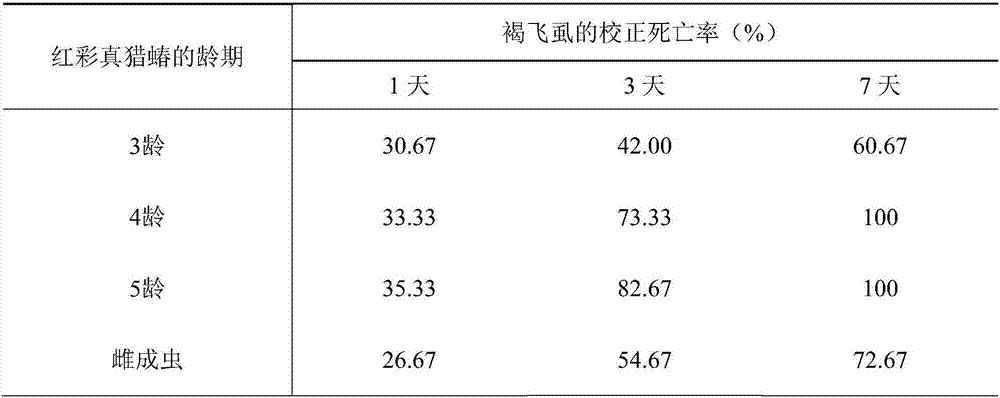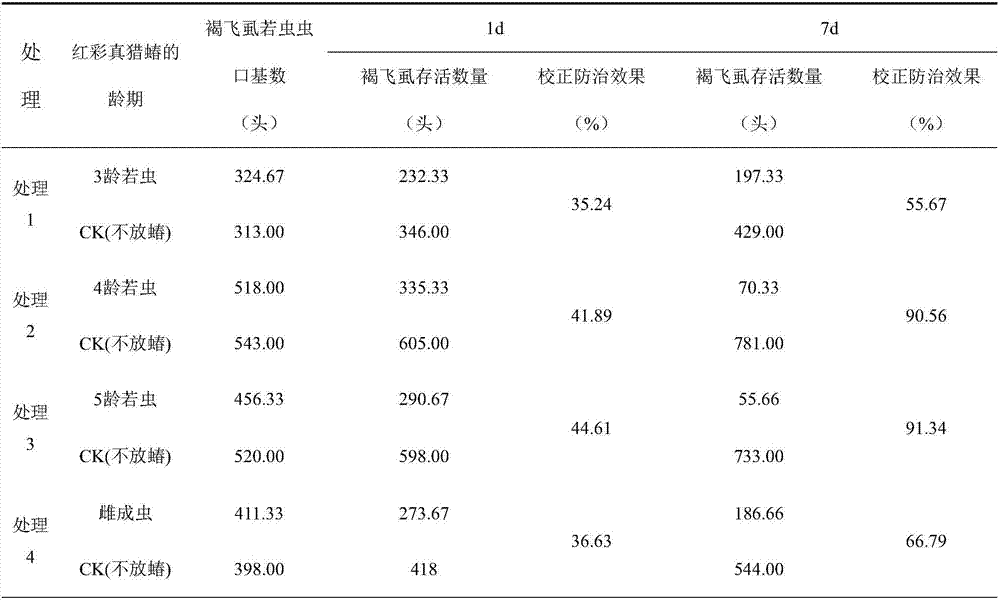Method for preventing and controlling brown planthopper by using harpactor fuscipes
A technology for hunting stink bugs and brown planthoppers, which is applied in the field of biological control of harmful organisms, can solve problems such as environmental pollution, endanger human health, cannot reduce planthoppers, etc. Effect
- Summary
- Abstract
- Description
- Claims
- Application Information
AI Technical Summary
Problems solved by technology
Method used
Image
Examples
Embodiment 1
[0023] Present embodiment 1 is the breeding method of the red-coloured stinkbug, and its steps are as follows:
[0024] (1) Place fresh green tobacco leaves in a plastic box with a bottom diameter of 12cm and a height of 5cm. The tobacco leaves can touch the periphery of the plastic box. The top of the box has air holes;
[0025] (2) placing the aged nymphs of Tenebrio molitor and the mated female adults of the red-colored stinkbug on the tobacco leaves, and the ratio of the number of the female adults of the red-colored stinkbug after the mating to the advanced age nymphs of Tenebrio molitor is 1:3~ 5;
[0026] (3) Place the plastic box in an artificial climate box with a temperature of 28±2°C and a relative humidity of 60±15%, and the light-to-dark ratio L:D=14h:10h;
[0027] (4) Check whether the female adult of the red-colored stinkbug is laying eggs every day, after laying eggs, the female adult of the red-colored stinkbug is taken out, and can mate with other male adul...
Embodiment 2
[0038] Present embodiment 2 is the predation ability test of the red-coloured stinkbug, and its steps are as follows:
[0039] 1. Plant rice in the tillering stage in a plastic bucket with a diameter of 25 cm, use evenly perforated organic cellophane to make enclosures, and use gauze and rubber bands to add a cover to prevent the test insects from escaping;
[0040] II. Place the plastic barrel in a well-ventilated and well-lit outdoor environment with an average daily temperature of 25±2°C;
[0041] III. Before the test, the 3rd instar nymph, the 4th instar nymph, the 5th instar nymph and the female adult were satiated for 24 hours, then starved for 48 hours to test;
[0042] IV. Inject 30 3 age brown planthoppers on potted rice plants and raise them. When they grow up to 4 ages, put the 3 age nymphs and 4 age nymphs of the red-coloured stinkbug after the processing of step III in the plastic bucket respectively. Instar nymphs, 5th instar nymphs and female adults.
[0043] ...
Embodiment 3
[0048] Present embodiment 3 is the method for utilizing the red-coloured stinkbug to prevent and control brown planthopper, and the steps are as follows:
[0049] Step 1, when the target paddy field is at the tillering stage or the heading stage, use the five-point sampling method to sample the brown planthopper in the target paddy field and identify its age;
[0050]Step 2, when it is identified that the age of the brown planthopper is 2-3 ages, then use the survey sampling method to investigate and count the population density of the 2-3 ages of the brown planthopper in the target paddy field, the target paddy field of this embodiment 3 5m 2 In the plot, the parallel jumping method was used to survey the target rice fields. Each point investigated 2 families, and a total of 30 rice families were investigated. Use a white porcelain plate to brush a layer of engine oil and place it obliquely on the middle and lower part of the rice, and quickly pat the rice plants twice. , an...
PUM
 Login to View More
Login to View More Abstract
Description
Claims
Application Information
 Login to View More
Login to View More - R&D
- Intellectual Property
- Life Sciences
- Materials
- Tech Scout
- Unparalleled Data Quality
- Higher Quality Content
- 60% Fewer Hallucinations
Browse by: Latest US Patents, China's latest patents, Technical Efficacy Thesaurus, Application Domain, Technology Topic, Popular Technical Reports.
© 2025 PatSnap. All rights reserved.Legal|Privacy policy|Modern Slavery Act Transparency Statement|Sitemap|About US| Contact US: help@patsnap.com



